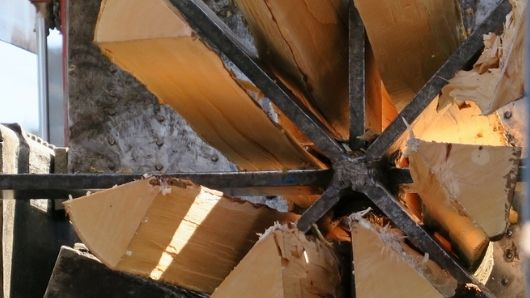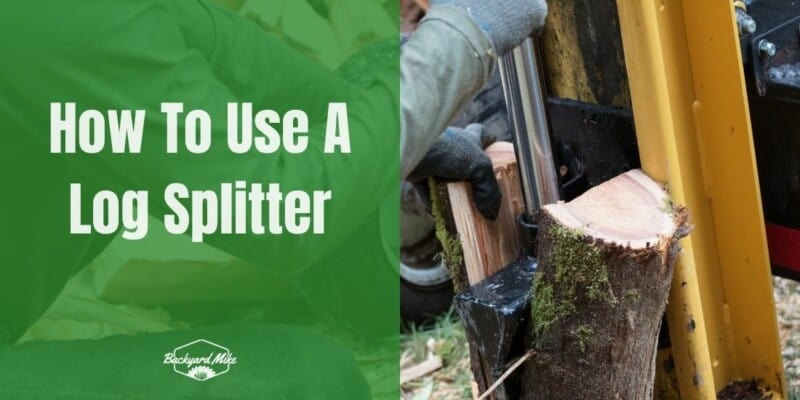Welcome to this article about how to use a log splitter!
A log splitter can be very useful, especially if you want to cut firewood to the perfect size.
But sometimes, using a log splitter can be very difficult, especially if you’re a beginner.
Don’t worry though, after reading this article, you’ll know how to split wood with a log splitter like a pro!
Safety Instructions
It’s important to make sure you don’t lose your hands and stay clear from injuries while using a log splitter.
So make sure you take some safety measures. Here are some safety tips to ensure you don’t injure yourself.
Safety Equipment
One way to stay safe is to make sure you have the right equipment. Here is some safety equipment for when you use a log splitter. These will help keep you from losing a hand!
- Safety goggles. This makes sure that pieces of wood won’t fly into your eyes.
- Thick gloves. Protects your hand from any splinters in the wood.
- Safety boots. So that no injuries happen if logs fall on your feet.
- Helmet. Same concept of the safety boots, you don’t want to hit your head with logs.
If you use these, it can do wonders in keeping you safe.
ALSO READ: Best Wood Splitter – Reviews
Safety Tips
Other than safety equipment, here are some safety tips you can do to avoid injuries.
- Use the log splitter in the daylight. This is to ensure you can see clearly. If you use it in the nighttime, you won’t be able to see properly.
- Limit to one operator per machine. Even if there are two of you, make sure the other person stays far away from the blades.
- Make sure there is no leakage in the hydraulic pipes before starting.
- Make sure the supporting beam lock is locked before starting. If the beam isn’t properly locked, there could be a disaster.
- One log at a time. Don’t rush by trying to split multiple logs at a time. It could cost you your fingers.
- Don’t use your legs to stabilize the log. Keep your legs away to avoid injuries.
- Hold the log in the middle, not the ends. Immediately remove your hands when the log hits the wedge
- Keep your workspace clean. You wouldn’t want to end up tripping and landing on your splitter. You should clear your work area before starting.
- Take caution when changing the hydraulic or engine fluid. You don’t want to start a fire.
- Make sure your clothes aren’t loose. This is so that they won’t get stuck in any of the machinery.
If you follow all these safety tips and take caution when using the machine, you should be safe.
Using a Log Splitter: Step By Step
Here is a step-by-step guide on how to use a log splitter and effectively cut firewood for your home.
1) Read The Manual
Every log splitter is different, so read the manual to learn the specifics of your own splitter. This is both for safety reasons and to make sure you’re using your log splitter to the best of its ability.
Not just that! But also because you want to ensure you know exactly how your log splitter runs, and what the particular safety precautions are.
It may seem pointless, but the instructions give a clear idea of the maintenance and functions of your log splitter.
It will tell you how to use the control handle, and might even touch on the safety gear you might need.
2) Setting Up
This applies to both the person using it and the machines.
Prepare yourself mentally and physically by taking into account all the safety precautions.
Remove any jewelry or loose items before starting.
Things like watches and rings could get stuck in the machine. Also make sure to wear protective gear, like your safety glasses and safety shoes. Try not to wear loose clothing as well to avoid it getting stuck.
Once you are prepared, you want to get the machine ready. Depending on the instruction manual, this could be done in a different number of ways. But here are some general guidelines
- Make sure you’re in an open area in the daylight.
- Clear your work area from clutter.
- Make sure the wood you want to split is nearby, but not in an area you could easily trip over it.
- Set up the splitter on a level surface.
- You could put bricks or cinder blocks around the wheels of the splitter to avoid it moving around.
3) Splitting Logs

When it comes down to splitting logs, it depends on whether you have a manual splitter or a powered splitter (either the gas log splitter or electric log splitter).
Before you start, you should only split one log at a time. Don’t do a Superman.
Make sure the machine you use will work.
So without further ado, this is finally the how to use a log splitter time of the article.
Manual Splitter
If your model is a manual splitter, then you’ll want to do the following.
- Ensure that the jack is tight. Insert the log into the jack then tighten the screw. This will make sure the log doesn’t move while you’re driving the wedge into it. If it’s not tight enough, the log may fall off or not be split all the way.
- Operate the machine by hand or foot pedal to drive the wedge into the log. Continue until the log is completely split. Make sure your hands are in a position not to be hurt while doing this.
- Put the cylinder back into starting position.
- To remove the log, loosen the screw on the jack.
- Repeat for all logs.
Powered Log Splitter
If the model you’re using is gas-powered or electric-powered, you will be using the splitter a little differently from how you’d use a manual.
- Make sure the machine has enough gas to finish the job. If it’s an electric log splitter, make sure it’s plugged in.
- Whether you want to split wood horizontally or vertically, make sure the beam is locked. The beam should automatically lock in a horizontal position but do double-check.
- Position the log so that it’s sitting on the wedge.
- Activate the wedge by moving the control handle forward to split the piece of wood. Some machines turn on with a lever and some with a button. Read you’re manual to figure out how exactly to do this.
- Once the log is split, set the control handle to reverse, so the wedge is removed.
- Once the wedge is back at its starting position, remove the log pieces and repeat.
Again, make sure to read the manual. Sometimes, the control handle has different settings, and that means you should operate it accordingly as instructed.
Though usually, the control handle has three settings: forward, neutral, and reverse.
- Forward position: When the control handle is in the forward position, the wedge will move forward. This is how it cuts the wood.
- Neutral position: When the control handle is in the neutral position, it is at rest, meaning it isn’t moving. It serves as a hand brake for the wedge.
- Reverse position: When the control handle is in the reverse position, it goes backward. This is used when you’ve finished splitting the log and you want to retract the wedge back to starting position.
After you finish, wipe down your machine so that there’s nothing lodged in it.
Which Type of Log Splitter is Good for You?
There are different types of log splitters. Each has its advantages and disadvantages and suits, different people.
All of these are great at cutting wood, it’s just a matter of personal preference on which one to get.
Manual Log Splitters
It can either be hand-powered or foot-powered.
This machine has the lowest pressure rating among all types of splitters. It’s not capable of handling super big logs.
Some versions of manual log splitters have hydraulic weights or pumps that drive the wedge into the wood. But do note, that since they still require manpower, it is still considered manual.
This is great for people who only use a log splitter occasionally and want something affordable.
Gas Powered Log Splitters
This is the most powerful among the types of log splitters.
A gas-powered log splitter can handle larger pieces of wood.
It has a high-pressure rating.
It doesn’t have to be plugged in. This is great because it doesn’t limit your location. You can split logs wherever you like.
However, this machine is the most expensive option. Not only do you have to pay for the price of the log splitter, but you also have to pay the price for the gas and maintenance.
This type of log splitter is great for those who need a powerful machine that can split big pieces of wood.
Electric Log Splitters
This log splitter is a great middle-ground of the previous two we described.
It has a mid-pressure rating and can handle larger pieces of wood than the manual splitter, but not as much as the gas splitter.
However, an electric log splitter is powered by electricity, so it has to be plugged in while you’re using it. This limits where you can use the log splitter but also makes it more portable and easier to store.
You can use this both indoors and outdoors, which come in pretty handy.
This would be ideal for a person who would want a versatile log splitter.
Hydraulic Vs. Kinetic Log Splitters
In addition to the different types of log splitters, you can also choose between a hydraulic and kinetic log splitter. Whichever one you choose, you shouldn’t have issues with cutting wood.
Hydraulic Log Splitter
These feature a hydraulic pump, meaning they can either have an electric or gas engine.
When it is switched on, the pump forms a stream of pressured oils. This generates power to push the wedge through the log.
A hydraulic splitter is convenient to use, especially if you suffer from back problems.
However, they don’t cut gnarly and stringy logs that well.
These are available in vertical and horizontal models. The vertical position is great if you don’t want to hurt your back doing any heavy lifting.
These are quite popular and easy to find in the market.
Kinetic Log Splitter
This machine operates through a different method and is engineered differently. Although, it’s not as well known as hydraulic log splitters despite kinetic energy being around for ages.
A kinetic log splitter is designed to propel and store energy from the gas engine.
Another thing to note is it uses a flywheel system that extracts energy from the engine in the spinning flywheels, which means…
These cut the logs at a very quick pace.
Since there is no hydraulic pump or oil, it’s a lot easier to maintain than a hydraulic log splitter. You won’t need to worry about oil leaks.
One Last Thing Before You Start
So you now have the knowledge of how to use a log splitter. We hope you enjoyed reading and learned from this article!
Just remember to always put your safety first. Wear clothing that isn’t loose, safety shoes, thick gloves, and safety goggles. Also, read the instruction manual of your log splitter before proceeding.
Take note of the position of the control handle. And whether or not the splitter is in the horizontal or vertical position, make sure the beam is locked.
And remember to have fun with it!
Now you can get to work and make firewood for your home!


